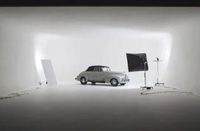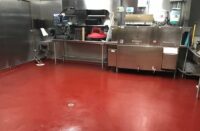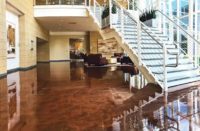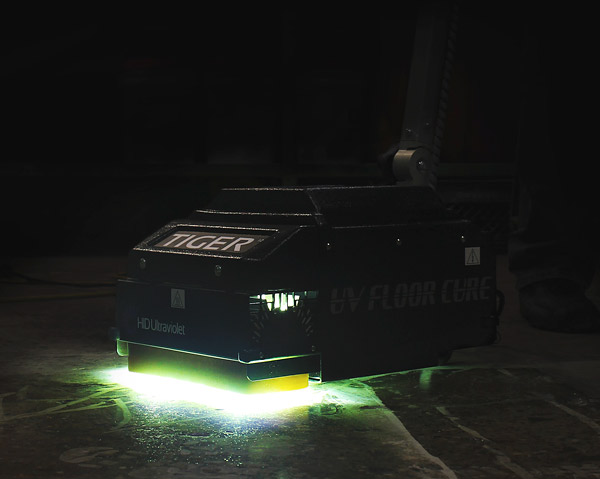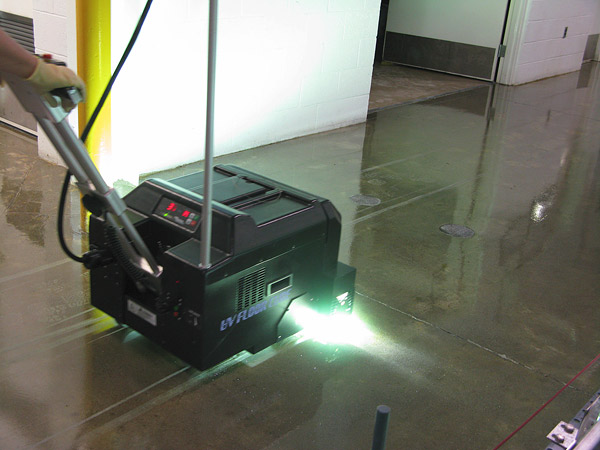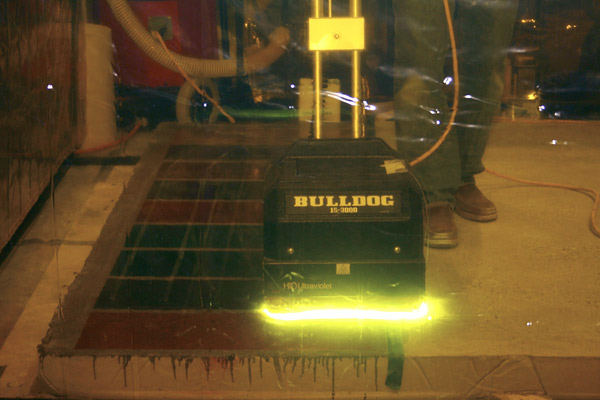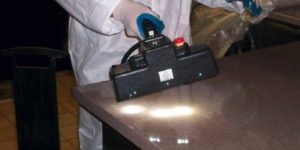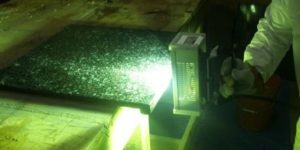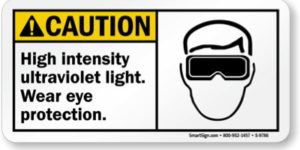Concrete artisans and contractors are always searching for the ideal coating, but end-users and equipment manufacturers are behind the latest push for one specific coating formulation — UV-cure.
Clear coatings that cure in seconds by exposure to high-intensity ultraviolet light have many uses, from DVDs to dentistry. The coatings reach full cure in just seconds, so it’s easy to see why they would be attractive for concrete, and of interest developed a few years ago. But for most applications, the advantages of fast cure and premium stain and abrasion resistance failed to outweigh the cost of the material and equipment, and the learning curve to use it. Interest leveled off and many formulators exited the market.
But that wasn’t the end. Some customers can’t wait even eight hours to get back on a floor and others require coatings with high stain and abrasion resistance with little VOCs and off-gassing. For them, UV-cure coatings look like a real problem-solver.
So, prompted by big end-users and nudged along by UV equipment manufacturers, some formulators are introducing new coatings aimed at very specific applications. Here are their stories.
Not just supersize — industrial size
Food acids and forklifts are a deadly combination for any floor, but a way of life in most large food processing plants. Plus, at factory scale, shutting down for even a day to wait for a floor to cure costs thousands of dollars. UV-cure coatings are just about their only option.
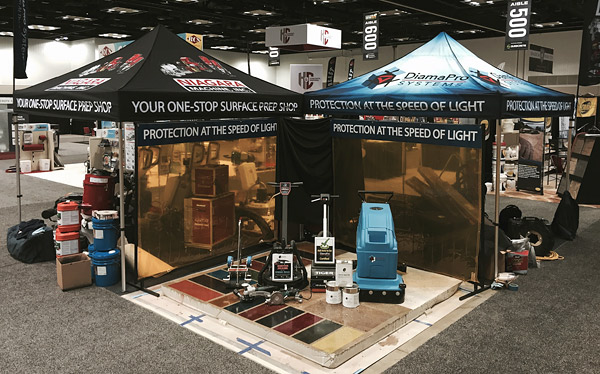
A new coating, DiamaPro Systems UV-HS, which is distributed by Niagara Machine, allows contractors to produce a protected floor that can be put into full service as soon as they leave the site. As a one-component aliphatic urethane, the coating is low in VOCs, odorless once cured and has an unlimited pot life. It is also formulated to reduce the marring resulting from forklifts and other machinery.
DiamaPro Systems coating specialist Scott Thome recommends applying the company’s surface conditioner to a prepared concrete floor during the surface preparation step. This allows the coating, which is applied at 1-2 mils, to develop a thin, uniform, pinhole-free protective surface. The conditioner also hardens the concrete over time, prolonging the system’s service life.
The next step is to apply the coating. Thome recommends using two-person crews on sections of about 2,000 to 3,000 square feet. This allows the crew to apply the coating and cure it before it penetrates too deeply. One person runs the UV-cure equipment (also called a light and similar in size and shape to a lawn mower) and the other manages the cord. Two coats are recommended. A two-person crew with a large light can efficiently coat and cure about 1,500 square feet in an hour. And this is final cure, not initial cure.
Even a fast-curing polyaspartic may not reach full cure (i.e., be ready for forklift traffic) for up to 48 hours.
The DiamaPro Systems coating seems to be racking up an impressive record. Take, for example, the largest peanut butter plant in the U.S. Each day the equivalent of 11 train cars of peanuts enter on forklifts through a single door. That’s a lot of forklift tire spinning. The UV-cure coating on the floor by that door still looks new after a year and a half of that punishing treatment.
Food processing plants are not the only beneficiaries. Several restaurant chains are seeing the advantages of a coating that can give their floors immediate protection from food, traffic, even snow-melt chemicals.
Concrete contractor Nicole Poteet, president of Preferred Dallas LLC in Grand Prairie, Texas, likes the DiamaPro Systems coating. After using it in the product distribution center of a large candy manufacturer, she said it seemed more durable and scratch resistant than other UV-cure coatings she’s tried.
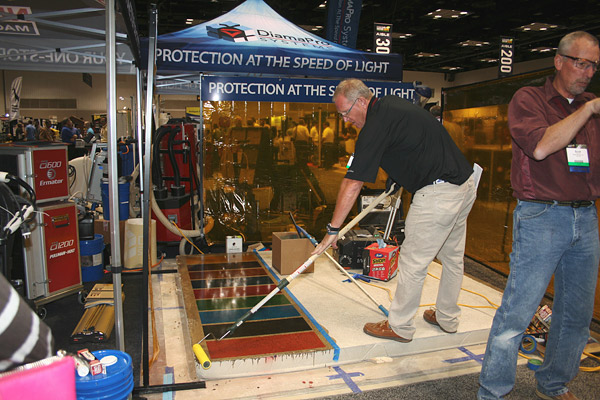
Big boxes mean big floors
Koster American Corp. is in the floor protection business. One of its large customers, a big box retailer, found that stripping and rewaxing floors every night for eight or 10 weeks and then starting over again was costing about $300,000 per year, per store. They wanted an easy maintenance system that could be installed without interfering with shoppers. Koster owns its own R&D lab and manufacturing, so it developed the Koster UV-Cure Polyurethane Floor Coating to add to its line of floor coating and repair products. The product has zero VOCs, is odor-free and is made in the U.S.
The Koster system forms a film, so no primer is used. The company recommends rolling out three coats of 3 mils each and allowing each coat to dry for a half hour before curing it and applying the next coat. Koster President Raymond Hicks says its testing confirms the coating should last three to five years. If recoating is required in high-traffic areas, it can be accomplished in most cases by screening and buffing first and then applying a single coat.
Koster customers are property owners, not contractors, but the company trains and approves preferred applicators, who are expected to have access to the UV-cure equipment.
What about countertops?
A lot of early interest in UV-cure coatings came from countertop fabricators because of the potential to resist common food stains and their quick turn-around time. Difficulty in achieving the desired appearance slowed this demand, and several suppliers moved away from the technology. One who stayed and continued improving it is Surface 519. Its original UV-cure product was a 100 percent solids product called Stonecure. According to owner Troy Thompson this coating delivers “unbelievable stain protection and is very durable.” But, he says, “There is a post-cure sanding process required to achieve a matte or satin finish.”
Sanding can hone the surface down to where it looks very natural, soft and smooth or polish it up to a high gloss that looks like granite or even glass. The end result is impressive, but most contractors are accustomed to being finished when the sealer is applied, so it feels like an extra step to polish afterwards. However, even with the polishing step, Thompson says an artisan can seal a countertop, cure it and polish it in one day and then install it the next day. And since the UV-cure coating reaches final cure immediately, there is no need to ask customers to “baby it” for a few days.
Besides being stain-resistant, the coating can withstand hot dishes and pots up to 450 degrees. However, using a knife to cut directly on the counter will dull and damage the finish over time.
To eliminate the post-cure sanding step, Surface 519 recently introduced a new water-based urethane-acrylic resin coating called RockTop UV WB500. This product is available in matte or gloss finishes. The two can be mixed for more of a satin look. Because it is waterborne, it has to dry for anywhere from one to four hours before curing. This still allows a contractor to apply and cure two coats in a day and install the countertop the next day.
Like other UV-cure coating suppliers, Surface 519 trains and certifies applicators. While UV curing is not difficult, Thompson says, “There is a learning curve. The whole process is different — you don’t just apply it and walk away.”
Old solution solves new problem
DIC Imaging Products USA LLC, a long-standing supplier of UV-cure coatings for optical media like Blu-ray Discs, is entering the concrete UV-cure coating market from yet a different direction.
Recently, a manufacturer of UV curing equipment helped the company recognize its technology was well suited for site-applied UV-cure coatings for concrete surfaces, as well as ceramic, terrazzo, vinyl composite tile and wood. DIC’s 100 percent solids floor coating line is called OneCure. Three different systems deliver different looks on concrete: high gloss or satin, wet and darker, or dry and natural. All can be applied on floors ground to 100 to 200 grit. Again, some training is required.
The product is available from the OneCure facility in Oak Creek, Wisconsin. “If you are someone who pays attention to detail and wants to do a good job, you’ll have a lot of success with our system,” says Kevin Orcutt, vice president of sales and marketing.
A word about equipment
One of the biggest hurdles to entering the UV-cure coating market is access to curing equipment. Poteet, the contractor from Texas, points out it is a big investment for a contractor who’s not sure there will be a customer base. She recommends renting the equipment at least in the beginning and to be sure to include that cost in the bid. Niagara Machine rents equipment supplied by HID Ultraviolet to contractors. Koster works with light supplier Jelight Co. Inc. In addition to its materials, Surface 519 leases and sells handheld lights from HID on its website.
Intense UV light is hazardous to eyes and skin, so proper equipment, protective clothing and, above all, training, are required to keep workers and bystanders safe.
Material costs plus equipment costs can make UV-cure coatings expensive. But for those end-users who need a strong, durable finish with excellent chemical resistance and don’t have the luxury of time, a UV-cure coating may be the best option.
www.diamaprosystems.com
www.kosterusa.com
www.onecure.net
www.surface519.com
www.hid.com
www.jelight.com
